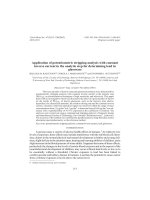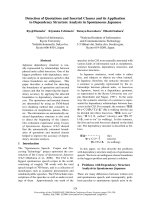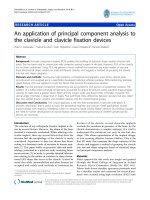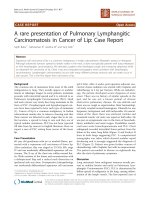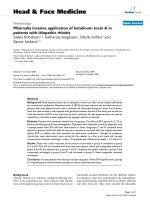APPLICATION OF SOMATIC VARIANT ANALYSIS IN CANCER EXOMES
Bạn đang xem bản rút gọn của tài liệu. Xem và tải ngay bản đầy đủ của tài liệu tại đây (3.72 MB, 204 trang )
APPLICATION OF SOMATIC VARIANT ANALYSIS IN
CANCER EXOMES
YU WILLIE SHUN SHING
NATIONAL UNIVERSITY OF SINGAPORE
2015
APPLICATION OF SOMATIC VARIANT ANALYSIS IN
CANCER EXOMES
YU WILLIE SHUN SHING
(B.Sc., UNIVERSITY OF CALIFORNIA, BERKELEY
M.Sc., BOSTON UNIVERSITY)
A THESIS SUBMITTED FOR
THE DEGREE OF DOCTOR OF PHILOSOPHY
NUS GRADUATE SCHOOL OF INTEGRATIVE
SCIENCES AND ENGINEERING
NATIONAL UNIVERSITY OF SINGAPORE
2015
Declaration
I hereby declare that this thesis is my original work and it has been written by me in
its entirety. I have duly acknowledged all the sources of information which have been
used in the thesis.
This thesis has also not been submitted for any degree in any university previously.
____________________________
YU Willie Shun Shing
28 December, 2014
i
Acknowledgements
First of all, I like to thank my father and mother for their unwavering love, support
and patience over the years; it has been a long journey and I have finally made it.
I like to thank my uncle Michael, aunt Irene, Bernie, Li-Ann and Bebo for making me
feel welcome in Singapore and helped make this country like a second home for me.
Thank you to my supervisors, Prof. Patrick Tan and Prof. Teh Bin Tean, for giving
me the once-in-a-lifetime opportunity to do research at and to witness firsthand the
birth of the cancer genomics era.
Thank you to Prof. Steve Rozen for your constructive advice on the computational
aspects of cancer genomics. I look forward to working with you in the future.
Thank you Lian Dee for being there for me over the years; talking to you everyday
has pushed me to keep in touch with experimental biology and made me realize it is
an important partner to bioinformatics.
Finally, thank you Singapore for creating the environment where genomics research is
not only possible but thriving. Happy 50
th
birthday.
ii
Two Quotes for Scientific Investigators
“The fact that the scientific investigator works 50 percent of his time by non-rational
means is, it seems, quite insufficiently recognized.
Intuition, like a flash of lightning, lasts only for a second. It generally comes when
one is tormented by a difficult decipherment and when one reviews in his mind the
fruitless experiments already tried. Suddenly the light breaks through and one finds
after a few minutes what previous days of labor were unable to reveal.
And, Randy’s favorite,
As to luck, there is the old miners’ proverb: 'Gold is where you find it.' “
Neal Stephenson, Cryptonomicon
“TWO roads diverged in a yellow wood,
And sorry I could not travel both
And be one traveler, long I stood
And looked down one as far as I could
To where it bent in the undergrowth;
Then took the other, as just as fair,
And having perhaps the better claim,
Because it was grassy and wanted wear;
Though as for that the passing there
Had worn them really about the same,
And both that morning equally lay
In leaves no step had trodden black.
Oh, I kept the first for another day!
Yet knowing how way leads on to way,
I doubted if I should ever come back.
I shall be telling this with a sigh
Somewhere ages and ages hence:
Two roads diverged in a wood, and I—
I took the one less traveled by,
And that has made all the difference. “
Robert Frost, The Road Not Taken
iii
Table of Contents
Acknowledgements …………………………………………………………………. i
Two Quotes for Scientific Investigators …………………………… ii
Table of Contents .…………………………………………………………………. iii
Summary .………………………………………………………………………… vi
List of Figures ………… ………………………………………………………. viii
List of Tables …… ……………………………………………………………… x
List of Abbreviations ………… ………………………………………………… xii
Chapter One: Introduction ………………………… ……………………… 1
1.1 Somatic theory of evolution and the central role of the genome in cancer
development ……………………………………………………………………… 2
1.2 Development of technologies to catalog and understand somatic mutations in
cancer …………………………………………………………………………… 3
1.3 Description of general variant discovery pipeline used in analysis of next
generation whole-exome sequencing data … ……………………… 8 - 16
1.3.1 Sequenced DNA data in FASTQ format ……… …….…………… 9
1.3.2 Alignment of DNA fragments to the reference genome …… ……. 10
1.3.3 PCR-duplicate removal ………… ……………………………… 10
1.3.4 Variant calling and separation of somatic, germline and SNP variants
………………………………………………………………………………. 11
1.3.5 Visualization and estimation of copy number and loss of heterozygosity
changes ………………………… ……………………………………… 13
1.3.6 Inferring mutational processes in a tumour …………… ………… 15
1.4 Application of variant discovery pipeline … …………………… ……… 17 - 20
1.4.1 Summary of chapter two ……………………………… …………. 17
1.4.2 Summary of chapter three …………………………………… … 18
1.4.3 Summary of chapter four …………………………………………… 19
iv
Chapter Two: First Somatic Mutation of E2F1 in a Critical DNA Binding
Residue Discovered in Well- Differentiated Papillary Mesothelioma of the
Peritoneum ……………………………………………………………… …… … 24
2.1 Introduction ……………………… ………………………………………… 25
2.2 Results ……………………… …………………………………………. 27 - 31
2.2.1 WDPMP whole-exome sequencing: mutation landscape changes big and
small ………………… ……………………………………………….… 27
2.2.2 E2F1 R166H mutation affects critical DNA binding residue ………. 28
2.2.3 R166H mutation is detrimental to E2F1’s DNA binding ability and
negatively affects downstream target gene expression ….……………… 30
2.2.4 Cells over expressing E2F1 R166H mutant show massive protein
accumulation and increased protein stability …………………………… 31
2.2.5 Over expression of E2F1 R166H mutant does not adversely affect cell
proliferation …….………………………………………………………… 32
2.3 Discussion …… ……………… ……………………………………… 33 - 38
Chapter Three: Exome Sequencing of Liver Fluke-associated
Cholangiocarcinoma ……………………………………………………………… 52
3.1 Introduction …………………………… ……………………………………. 53
3.2 Results ………………………………… ………………………………. 55 - 58
3.2.1 Clinical samples and information …………………………….…… 55
3.2.2 CCA whole-exome analysis ……………………………….……… 55
3.2.3 Mutational analysis of CCA discovery set …………………………. 56
3.2.4 Prevalence analysis of somatic mutations found in CCA discovery set
………………………………………………………………………………. 56
3.2.5 Mutational landscape comparison between O. Viverrini-associated
cholangiocarcinoma, pancreatic ductal adenocarcinoma and hepatitis C virus-
associated hepatocarcinoma …………………………………………… 58
3.3 Discussion …… ……………………………………………………… 59 - 67
Chapter Four: Whole-exome sequencing studies of parathyroid carcinomas
reveal novel PRUNE2 mutations, distinctive mutational spectra related to
APOBEC-catalyzed DNA mutagenesis and mutational enrichment in kinases
associated with cell migration and invasion … ……………………………… 93
4.1 Introduction … ……………………………………………………….……… 94
4.2 Results …………………………………………………………………… 95 - 99
4.2.1 Clinical samples and information ………………………………… 95
v
4.2.2 PC whole-exome analysis ………………………………………… 96
4.2.3 CDC73 mutational status and its effect on the PC exome …………. 97
4.2.4 Novel recurrent mutations of PRUNE2 in PC ……………………… 97
4.2.5 Kinase family is recurrently mutated in PC independent of CDC73
mutation status 98
4.2.6 APOBEC mutational signature in PC ……………………… ……. 99
4.3 Discussion ……… …………………………………………………… 100 - 106
Chapter Five: General Discussion and Future Work ………………… …… 148
5.1 General discussion …………….……………………………………… 149 - 155
5.2 Hypothetical research proposal ……….………………………………. 156 - 162
5.2.1 Title …… …… ………………………………………………… 156
5.2.2 Introduction …… ………………………………………………… 156
5.2.3 Conjecture ……… ……………………………………………… 158
5.2.4 Proposed mechanism …………………….……………………… 158
5.2.5 Proposed milestones ………….…………………………………… 159
5.2.6 Proposed experiments ………….………………………………… 159
5.2.7 Conclusion ……… ………………………………………………. 161
References ………………………………………………………………… 163- 184
vi
Summary
Whole-exome sequencing has revolutionized cancer research to accelerate the
exploration and cataloging of somatic variants across multiple cancer samples. As the
use of whole-exome sequencing is becoming increasingly prevalent, two natural
questions arises: One is how to process and analyze the ever growing volume of
sequencing data generated and the other is how to apply the results of the analysis to
cancer research.
To start to answer the former, a general single nucleotide variant discovery
pipeline is proposed to process and analyze whole-exome data; the results from this
pipeline will be the starting points for downstream analysis such as functional analysis
and cataloging of mutations, estimating copy number and loss of heterozygosity, and
inferring mutational processes.
To start answering the latter question, three published studies will illustrate
three possible applications of whole-exome sequencing.
The first study is whole-exome sequencing of well differentiated papillary
mesothelioma of the peritoneum. The first E2F1 somatic mutation was found and
predicted to result in a R166H change to the protein product. R166 position is highly
conserved and protein homology modeling indicates the position is a critical DNA
contact point for binding. Downstream experimentation confirmed loss of DNA
binding for E2F1 R166H mutant and also discovered that E2F1 mutant is much more
stable than its wild type counterpart. This study highlights a collaborative application
of bioinformatics with experimental biology where bioinformatics quickly predicts
vii
the functional consequences of a mutation and presents high confidence hypothesis
for experimental biologists to consider.
The second study is whole-exome sequencing of Opisthorhis viverrini (OV) -
related cholangiocarcinoma (CCA); a malignant bile duct cancer that is endemic in
northeastern Thailand due to OV infestation as a result of local dietary habits. In
addition to finding recurrently mutated cancer-related genes such as TP53 (44.4%
mutation rate), KRAS (16.7%) and SMAD4 (16.7%), another 10 novel recurrently
mutated genes were cataloged such as MLL3 (14.8%), ROBO2 (9.3%), RNF43
(9.3%), PEG3 (5.6%) and GNAS oncogene (9.3%). Similarities in mutated genes and
base substitution spectra between OV-related CCA, pancreatic ductal adenocarcinoma
(PDAC) suggests therapies effective for PDAC may also be effective in OV-related
CCA. Minnelide and LGK974, two therapeutics showing effectiveness against
pancreatic cancer with KRAS/TP53 mutations or RNF43 mutations respectively, were
suggested to be effective in treating CCAs with similar mutational background. This
study highlights the medical translational application of whole-exome sequencing and
analysis.
The third study outlines the mutational landscape of parathyroid carcinoma
(PC) through PC whole-exome sequencing. PRUNE2 is revealed to be the novel
second recurrently mutated gene in PC with germline and somatic mutations clustered
around an evolutionary conserved region of the protein. In addition, mutations to
members of the kinase family related to cell migration and invasion were found to be
enriched. APOBEC mediated mutagenesis was implicated for the first time in a subset
of PC patients with high mutational burden and early age onset of disease. This study
highlights the application of whole-exome analysis in opening new avenues of
research not previously considered under hypothesis-driven approaches.
viii
List of Figures
Figure 1.1: The ten hallmarks of cancer as defined by Hanahan and Weinberg …. 21
Figure 1.2: General variant discovery and analysis pipeline used for whole-exome
sequencing data sets …………………………………………………………… 22
Figure 1.3: FASTQ example and quality score encoding ……………………… 23
Figure 2.1: Cumulative WDPMP exome coverage for tumor, normal and purified
tumor cells … ………… ………………………………………………………… 39
Figure 2.2: Compact representation of WDPMP exome using Hilbert plot …… 40
Figure 2.3: Sequencing coverage at CDKN2A, RASSF1 and NF2 ………………… 41
Figure 2.4: Sanger sequencing validation of somatic single nucleotide variants found
in E2F1, PPFIBP2 and TRAF7…………………………………………………… 42
Figure 2.5: Location and conservation analysis of E2F1 R166H ………………… 43
Figure 2.6: Visualization of p.Arg166His mutation location in E2F1 ……… …. 44
Figure 2.7: Homology modelling of wild type and mutant E2F1 around R166 residue
……………………………………………………………………………… …… 45
Figure 2.8: E2F1 R166 mutation affects binding efficiency on to promoter targets
……………………………………………………………………………………… 46
Figure 2.9: Accumulation of mutant E2F1 protein in cells due to increased stability of
E2F1 R166 mutation …………………………………………………………… 47
Figure 2.10: Relative expression of E2F1 wild type or E2F1 mutant after co-
transfection with EGFP in MSTO-211H and NCI-H28 ………………………… 48
Figure 2.11: Over expression of E2F1 R166H mutant in two mesothelial cell lines
…………………………………………………………………………………….… 49
Figure 3.1: Mutational landscape of OV-associated CCA ……………………… 68
Figure 3.2: Proportion comparisons of mutational spectra in OV-associated CCA,
PDAC and HCV-associated HCC ……………………………………………… 69
ix
Figure 4.1: Mutational landscape of PC ………………………………………… 107
Figure 4.2: Copy number estimation of chromosome 1 for each whole-exome
sequenced PC sample using ASCAT 2.0 ……………………………………. 108- 112
Figure 4.3: Predicted LOH of chromosome 9 for sample 4 using ASCAT 2.0 ….113
Figure 4.4: Twenty eight mammalian species conservation analysis of PRUNE2
residue positions (Ser450, Val452, Gly455) corresponding to the three non-
synonymous mutations (c.1349G>A, c.1354G>A, c.1364G>A) found in PC … 114
Figure 4.5: Distribution of base substitutions in PC ……………………………. 115
Figure 4.6: Mutational signatures found by Emu …………………………………. 116
Figure 5.1: Life cycle of LINE-1 retrotransposon ………………………………. 162
x
List of Tables
Table 2.1: Overall WDPMP Exome Sequencing Summary ……………………… 50
Table 2.2: Putative somatic nonsynonymous mutations found using the single
nucleotide variant discovery pipeline …………………………………………… 51
Table 3.1a: Clinical information of the discovery set consisting of 8 patients
diagnosed OV-associated CCA ………………………………………………… 70
Table 3.1b: Clinical information of the prevalence set consisting of 46 patients
diagnosed OV-associated CCA ……………………………………………… 71 - 72
Table 3.2: Whole-exome sequencing summary of 8 matched pairs of OV-associated
CCAs …………………………………………………………………………… 73
Table 3.3: Nonsynonymous somatic mutations identified and validated in the
discovery set …………………………………………………………………. 74 - 85
Table 3.4: Recurrently mutated genes as well as known recurrently mutated genes
found in 54 OV-associated CCAs …………………………………………… 86 - 90
Table 3.5: Frequency of recurrently mutated genes in OV-associated CCA, PDAC and
HCV-associated HCC …………………………………………………………… 91
Table 3.6: Mutation spectra in OV-associated CCA, PDAC and HCV-associated HCC
………………………………………………………………………………………. 92
Table 4.1: Patient information for PC discovery set ……………………………. 117
Table 4.2: Sample information for PC validation set …………………………… 118
Table 4.3: PC whole-exome sequencing summary …………………………… 119
Table 4.4: Exome dbSNP concordance of whole-exome sequenced PC samples 120
Table 4.5: Validated single nucleotide variants for whole-exome sequenced PC
samples …… ………………………………………………………………. 121 - 136
xi
Table 4.6: Zygosity summary of validated somatic mutations for whole-exome
sequenced PC samples .……………………………………………………………. 137
Table 4.7: Recurrent mutations in CDC73 and PRUNE2 for whole-exome sequenced
PC ……………………………………………………………………………… 138
Table 4.8: Mutated genes related to DNA damage repair in sample 7b ……… 139
Table 4.9: Gene classification analysis of validated somatic mutations in PC
… 140 - 143
Table 4.10: Kinase mutations in PC …………………………………………… 144
Table 4.11: Gene classification analysis of validated somatic mutations in PC
excluding sample 7b … ……………………………………………………. 145 - 147
xii
List of Abbreviations
A
Adenine
A or Ala
Alanine
ABL1
Abelson murine leukemia viral oncogene homolog 1
ANOLEA
Atomic Non-Local Environment Assessment
AP1
Activating protein-1
APAF1
Apoptotic peptidase activating factor 1
APC
adenomatous polyposis coli
APOBEC
apolipoprotein B mRNA editing enzyme, catalytic polypeptide-like
APOBEC3C
Apolipoprotein B mRNA editing enzyme, catalytic polypeptide-like 3C
APOBEC3D
Apolipoprotein B mRNA editing enzyme, catalytic polypeptide-like 3D
APOBEC3G
Apolipoprotein B mRNA editing enzyme, catalytic polypeptide-like 3G
ARID2
AT rich interactive domain 2 (ARID, RFX-like)
ASCAT
Allele-Specific Copy number Analysis of Tumors
BAF
B allele frequency
BAP1
BRCA1-associated protein 1
BCH
BNIP-2 and Cdc42GAP Homology
BCR
Breakpoint Cluster Region
BGI
Beijing Genome Institute
BMCC1
Bcl2-/adenovirus E1B nineteen kDa-interacting protein 2 (BNIP-2) and
Cdc42GAP homology BCH motif-containing molecule at the carboxyl
terminal region 1)
BRAF
serine/threonine-protein kinase B-Raf
C
Cytosine
C or Cys
Cysteine
xiii
CASR
Calcium sensing receptor
CCA
Cholangiocarcinoma
CCNE1
Cyclin E1
CDC42BPA
CDC42 binding protein kinase alpha (DMPK-like)
CDC73
Cell division cycle 73
CDH11
cadherin 11, type 2, OB-cadherin (osteoblast)
CDK6
Cyclin dependent kinase 6
CDKN2A
Cyclin-dependent kinase inhibitor 2A
CGP
Cancer Genome Project
CHEK2
Checkpoint kinase 2
ChIP
Chromatin immunoprecipitation
CI
Confidence interval
COSMIC
Catalogue of somatic mutations in Cancer
CTNNB1
Catenin (cadherin-associated protein), beta 1, 88kDa
D or Asp
Aspartic Acid
DAVID
Database for Annotation, Visualization and Integrated Discovery
dbSNP
Single nucleotide polymorphism database
ddNTPs
di-deoxynucleotidetriphosphates
DMXL1
Dmx-like 1
DNA
deoxyribonucleic acid
dNTPs
deoxynucleosidetriphosphates
E2F1
E2F transcription factor 1
E2F4
E2F transcription factor 4, p107/p130-binding
EGFP
Enhanced green fluorescent protein
Emu
Expectation maximization
xiv
FFPE
Formalin fixed paraffin embedded
G
Guanine
G or Gly
Glycine
GATK
Genome analyzer toolkit
GNAS
GNAS complex locus
GROMOS
Groningen Molecular Simulation
HCC
Hepatocarcinoma
HCV
Hepatitis C virus
HDAC2
Histone deacetylase 2
HDAC4
Histone deacetylase 4
His
Histidine
HPT
Primary hyperthyroidism
HPT-JT
Hyperthyroidism-jaw tumor syndrome
HRAS
Harvey rat sarcoma viral oncogene homolog
I or Iso
Isoleucine
IDH1
Isocitrate dehydrogenase 1
IL17RA
Interleukin 17 receptor A
JAK1
Janus kinase 1
KAP1
KRAB-associated protein-1
kDa
Kilo Daltons
KRAB
Krueppel-associated box
KRAS
V-Ki-ras2 Kirsten rat sarcoma viral oncogene homolog
L or Leu
Leucine
Lbc
A kinase (PRKA) anchor protein 13
LIMK2
Lim kinase domain 2
xv
LINE-1
Long interspersed nuclear elements-1
LOH
Loss of heterozygosity
LTK
Leukocyte receptor tyrosine kinase
M or Met
Methionine
MAP3K11
Mitogen-activated protein kinase kinase kinase 11
MEKK3
Mitogen-activated protein kinase kinase kinase 3
MEN1
Multiple endocrine neoplasia type 1
MEN2A
Multiple endocrine neoplasia type 2A
MH2
Mad homology domain 2
MLL3
Lysine (K)-specific methyltransferase 2C
MPM
Malignant peritoneal mesothelioma
N or Asn
Asparagine
NDC80
NDC80 kinetochore complex component
NEDL1
HECT, C2 and WW domain containing E3 ubiquitin protein ligase 1
NF2
Neurofibromatosis type 2
NGF
Neuronal growth factor
NLRP1
NLR family, pyrin domain containing 1
NMF
Nonnegative matrix factorization
ODZ3
Teneurin transmembrane protein 3
OR
Odds ratio
ORF1
Open reading frame 1
ORF2
Open reading frame 2
OV
Opisthorhis viverrini
P or Pro
Proline
PA
Parathyroid adenoma
xvi
PARP1
poly (ADP-ribose) polymerase 1
PC
Parathyroid carcinoma
PCDHA13
Protocadherin alpha 13
PCM1
Pericentriolar material 1
PCR
Polymerase chain reaction
PDAC
Pancreatic ductal adenocarcinoma
PEG3
Paternally expressed 3
POLH
Polymerase (DNA directed), eta
PORCN
Porcupine homolog (Drosophila)
PPFIBP2
PTPRF interacting protein, binding protein 2 (liprin beta 2)
PRMT6
Protein arginine methyltransferase 6
PRUNE2
Prune homolog 2 [Drosophila]
PTEN
Phosphatase and tensin homolog
PTH
Parathyroid hormone
PTPRM
Protein tyrosine phosphatase, receptor type, M
Q or GLN
Glutamine
R or Arg
Arginine
RADIL
Ras association and DIL domains
RASSF1A
Ras association domain family 1 isoform A
RB1
Retinoblastoma 1
RhoA
Ras homolog family member A
RIOK3
RIO kinase 3
RNA
Ribonucleic acid
RNF43
Ring finger protein 43
ROBO2
Roundabout, axon guidance receptor, homolog 2 (Drosophila)
xvii
rtTA
recombinant tetracycline controlled transcription factor
S or Ser
Serine
SAD
SMAD4 activation domain
SHANK3
SH3 and multiple ankyrin repeat domains 3
SIAH1A
Siah E3 ubiquitin protein ligase 1A
SIRT1
Sirtuin 1
SMAD4
SMAD family member 4
SNP
Single nucleotide polymorphism
SNV
Single nucleotide variant
SV40
Simian vacuolating virus 40
T
Thymine
Tet
Tetracycline-Controlled Transcription Activation
TFDP1
Transcription factor, Dp1
TIE1
Tyrosine kinase with immunoglobulin-like and EGF-like domains 1
TP53
Tumor protein p53
TRAF7
TNF receptor-associated factor 7, E3 ubiquitin protein ligase
TRE
Tetracycline responsive element
UTR
Untranslated region
V or Val
Valine
WD40
Beta-transducin repeat 40
WDPMP
Well differentiated papillary mesothelioma of the peritoneum
XIRP2
Xin actin-binding repeat containing 2
Y or Tyr
Tyrosine
1
Chapter One: Introduction
2
1.1 Somatic theory of evolution and the central role of the genome in cancer
development
Majority of cells within an organism has only limited replicative potential; the
replicative trajectory of these cells inevitably leads to a state of senescence, where the
cell can no longer divide but still alive and metabolically active, and finally to
apoptosis, the process of programmed cell death. During these cells' limited lifetime,
they can accumulate changes to its genome. Some of the earliest observations of these
genomic changes were observed through microscopy in studies by Hansemann and
Boveri (1,2). By observing the characteristics of cancer cells undergoing cell
divisions, they noticed the chromosomes of cancer cells looked markedly different
from the chromosomes of normal cells. This led to the conjecture that cancer cells are
caused by genomic abnormalities. Following the elucidation of deoxyribonucleic acid
(DNA) structure as well as its role as the vehicle of inheritance, studies showed that
genomic DNA changes or somatic mutations can come about due to endogenous
processes, such as mistakes in DNA replication during cell division, or exogenous
processes, such as radiation or chemical insults (3,4,5). The key study demonstrating
the importance of abnormal genes in the development of cancer is the identification of
a naturally occurring sequence change in the form a guanine to thymine single base
substitution that results in a glycine to valine amino acid change in codon 12 of the
Harvey rat sarcoma viral oncogene homolog (HRAS) protein; insertion of total
genomic DNA containing this genetic mutation into NIH3T3 cells, a phenotypically
normal primary mouse embryonic fibroblast cells, resulted in conversion to cancer
cells (6).
Some somatic mutations confer increased survival and proliferation
capabilities in cells that acquired these mutations when compared with cells without
3
these mutations in the context of the local tissue environment. A classic example is
the development of chronic myeloid leukemia through a specific genomic
translocation event between chromosome 9 and chromosome 22 creating the
chromosomal anomaly known as the Philadelphia chromosome (7). This key
transformation event results in the creation of a fusion gene between the breakpoint
cluster region (BCR) gene and the Abelson murine leukemia viral oncogene homolog
1 (ABL1) gene where the resulting fusion protein product drives unregulated cell
division (8). Cells acquiring through mutations the ability to escape the normal cell
fate of senescence and apoptosis will hold a tremendous evolutionary advantage over
non-mutated cells in propagating their genetic material; therefore, cancer is a group of
mutated cells with advantageous mutations that sweeps through a cell population,
pushing aside cells lacking these mutations, to become the dominant cell type within
the context of its environment. In evolutionary terms, the development of cancer is
due to the process of positive selection or selection of adaptive traits that overcome
the replicative or growth limitations imposed on a cell. These adaptive traits displayed
by a cancer cell were classified into ten distinct categories by Hanahan and Weinberg
in two seminal review articles (9,10) (Figure 1.1).
1.2 Development of technologies to catalog and understand somatic mutations in
cancer
The key study demonstrating a single somatic base substitution to HRAS is
sufficient for cancerous transformation led to the continuous search for and cataloging
of gene mutations that is still ongoing. There are two critical technologies that first
enabled and subsequently accelerated our ability to discover these genetic mutations.
4
The first technology is DNA sequencing or the capability to generate single
base resolution of a DNA molecule. There are two methods of DNA sequencing
developed during the 1970's. The Maxam-Gilbert method employs chemical treatment
of radiolabelled DNA in four reactions to generate breaks at one or two of the four
nucleotides. Size separations of the chemically treated fragment were performed using
acrylamide gels with visualization through gel exposure to X-ray film (11). The
Sanger method employs the use of modified di-deoxynucleotidetriphosphates
(ddNTPs) to introduce premature terminations of DNA elongation at specific
nucleotides where normal deoxynucleosidetriphosphates (dNTPs) are substituted for
ddNTPs (12,13). There are four separate sequencing reactions where each reaction
contains one of the four possible ddNTPs, that is radio or fluorescent labeled, as well
as a mixture of the four normal nucleotides, the DNA template of interest, primer
oligonucleotides and DNA polymerases. After several rounds of DNA template
extension of each reaction mixture will result in DNA fragments of various sizes
ending at the site of ddNTP insertion; size separation using acrylamide gels of the
four reactions will enable the DNA sequence information to be deduced. Due to the
relative ease of use and lower use of radioactive and toxic chemicals, the Sanger
method became the dominant method of DNA sequencing that is still in use today.
The second technology is polymerase chain reaction (PCR) or the ability to
amplify small quantities of DNA fragments by several orders of magnitude. First
proposed by Kary Mullis in 1983, the method employ the heat-stable DNA
polymerases to replicate DNA and selective amplification is achieved by use of
oligonucleotides or a “primer” complementary to nearby DNA region of interest
(14,15). This method effectively eliminated the experimental biology bottle neck of
5
limited DNA availability and enabled much greater latitudes of experimental
manipulations.
Subsequent improvements and automation to the above two discoveries
enabled the application extension from examination of DNA sequences at a gene level
to the total DNA examination of an organism. In 1990, the publicly funded Human
Genome Project was started with the goal of sequencing and identifying the over three
billion nucleotides present in the human genome. In competition with the privately
funded Celera Genomics, who started sequencing the human genome in 1998, both
sides announced their sequencing draft of the human genome in February 2001 and
published their findings detailing methods used in production and analysis of the draft
sequence (16,17).
The availability of a human reference genome accelerated the study and
cataloging of genetic alterations in human cancer genomes in two ways. One, the
reference genome provide a single template for PCR primer design. This enables an
efficient, systematic design of primers with sufficient coverage to amplify larger and
larger portions of the protein coding regions in the human genome. In combination
with automated DNA-sequencing instruments based on the Sanger method, these
technologies enables a broader simultaneous sampling of the cancer genome through
sequencing of gene families, such as kinomes, to eventually sequencing most coding
exons of the genomes, now commonly called exomes (18,19).
Two, the reference human genome is a template where all subsequently
sequenced human DNA samples can be computationally mapped and compared
against. There is no longer a necessity to de-novo assemble each new sequenced
human genome of interest resulting in a tremendous saving in computational time;


